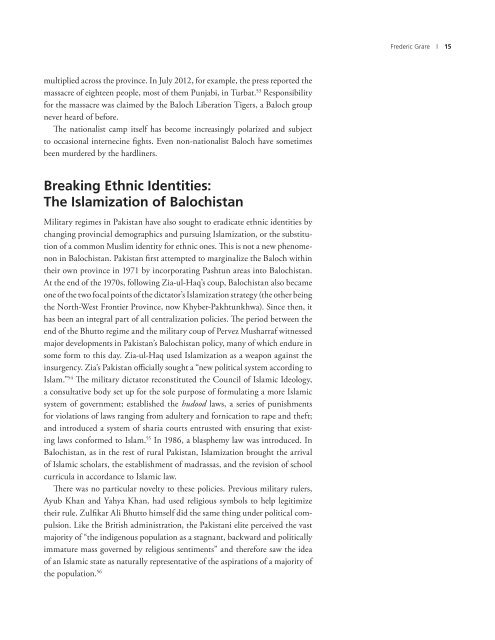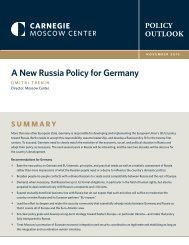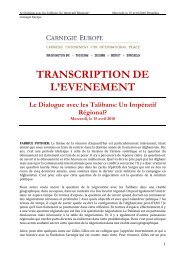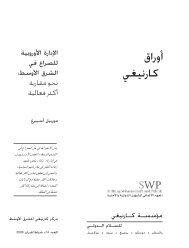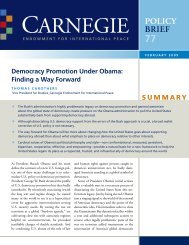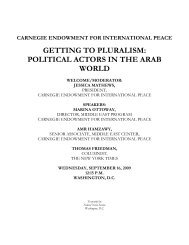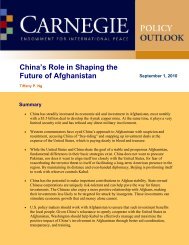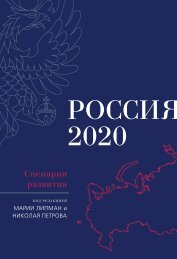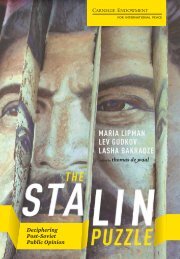BALOCHISTAN - Carnegie Endowment for International Peace
BALOCHISTAN - Carnegie Endowment for International Peace
BALOCHISTAN - Carnegie Endowment for International Peace
You also want an ePaper? Increase the reach of your titles
YUMPU automatically turns print PDFs into web optimized ePapers that Google loves.
multiplied across the province. In July 2012, <strong>for</strong> example, the press reported the<br />
massacre of eighteen people, most of them Punjabi, in Turbat. 53 Responsibility<br />
<strong>for</strong> the massacre was claimed by the Baloch Liberation Tigers, a Baloch group<br />
never heard of be<strong>for</strong>e.<br />
The nationalist camp itself has become increasingly polarized and subject<br />
to occasional internecine fights. Even non-nationalist Baloch have sometimes<br />
been murdered by the hardliners.<br />
Breaking Ethnic Identities:<br />
The Islamization of Balochistan<br />
Military regimes in Pakistan have also sought to eradicate ethnic identities by<br />
changing provincial demographics and pursuing Islamization, or the substitution<br />
of a common Muslim identity <strong>for</strong> ethnic ones. This is not a new phenomenon<br />
in Balochistan. Pakistan first attempted to marginalize the Baloch within<br />
their own province in 1971 by incorporating Pashtun areas into Balochistan.<br />
At the end of the 1970s, following Zia-ul-Haq’s coup, Balochistan also became<br />
one of the two focal points of the dictator’s Islamization strategy (the other being<br />
the North-West Frontier Province, now Khyber-Pakhtunkhwa). Since then, it<br />
has been an integral part of all centralization policies. The period between the<br />
end of the Bhutto regime and the military coup of Pervez Musharraf witnessed<br />
major developments in Pakistan’s Balochistan policy, many of which endure in<br />
some <strong>for</strong>m to this day. Zia-ul-Haq used Islamization as a weapon against the<br />
insurgency. Zia’s Pakistan officially sought a “new political system according to<br />
Islam.” 54 The military dictator reconstituted the Council of Islamic Ideology,<br />
a consultative body set up <strong>for</strong> the sole purpose of <strong>for</strong>mulating a more Islamic<br />
system of government; established the hudood laws, a series of punishments<br />
<strong>for</strong> violations of laws ranging from adultery and <strong>for</strong>nication to rape and theft;<br />
and introduced a system of sharia courts entrusted with ensuring that existing<br />
laws con<strong>for</strong>med to Islam. 55 In 1986, a blasphemy law was introduced. In<br />
Balochistan, as in the rest of rural Pakistan, Islamization brought the arrival<br />
of Islamic scholars, the establishment of madrassas, and the revision of school<br />
curricula in accordance to Islamic law.<br />
There was no particular novelty to these policies. Previous military rulers,<br />
Ayub Khan and Yahya Khan, had used religious symbols to help legitimize<br />
their rule. Zulfikar Ali Bhutto himself did the same thing under political compulsion.<br />
Like the British administration, the Pakistani elite perceived the vast<br />
majority of “the indigenous population as a stagnant, backward and politically<br />
immature mass governed by religious sentiments” and there<strong>for</strong>e saw the idea<br />
of an Islamic state as naturally representative of the aspirations of a majority of<br />
the population. 56<br />
Frederic Grare | 15


